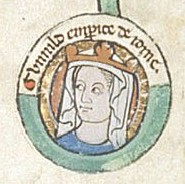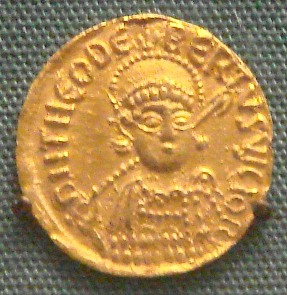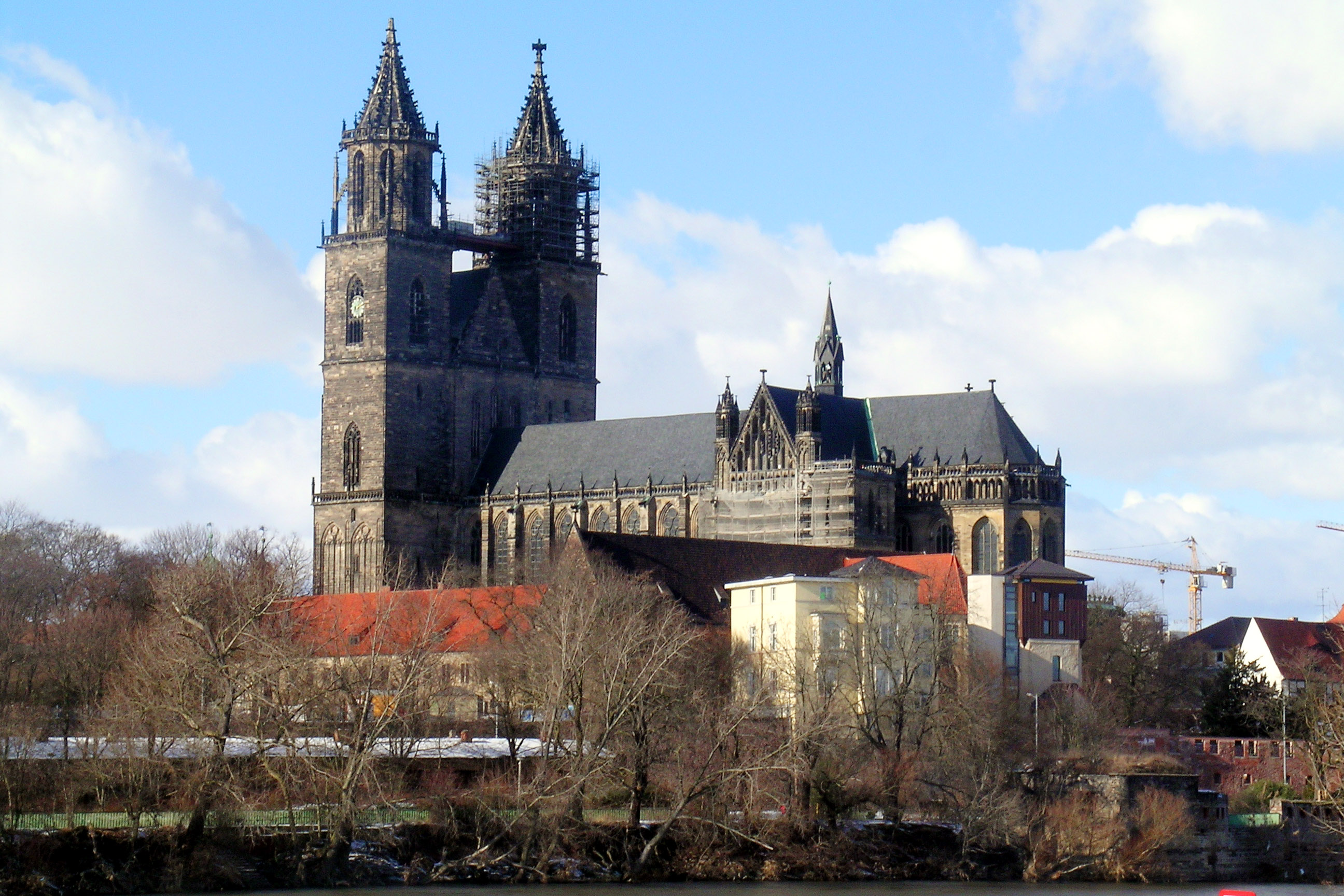|
Anno II
Anno II ( – 4 December 1075) was Archbishop of Cologne from 1056 until his death. From 1063 to 1065 he acted as regent of the Holy Roman Empire for the minor Emperor Henry IV. Anno is venerated as a saint of the Catholic Church. Life He was born to the ''edelfrei'' Steusslingen family at Altsteußlingen (near Ehingen) in Swabia, and was educated in Bamberg, where he subsequently became head of the cathedral school. In 1046 he became chaplain to the Salian emperor Henry III, and accompanied him on his campaigns against King Andrew I of Hungary in 1051 and 1052. The emperor appointed him provost at the newly erected Cathedral of Goslar in 1054 and Archbishop of Cologne two years later. Due to his dominant position at the imperial court, Anno was able to influence other appointments. Anno's nephew, Burchard, was made Bishop of Halberstadt in 1059, and in 1063, his brother, Werner, became Archbishop of Magdeburg. According to contemporary sources, Anno led an ascetic life and ... [...More Info...] [...Related Items...] OR: [Wikipedia] [Google] [Baidu] |
Catholic Church
The Catholic Church (), also known as the Roman Catholic Church, is the List of Christian denominations by number of members, largest Christian church, with 1.27 to 1.41 billion baptized Catholics Catholic Church by country, worldwide as of 2025. It is among the world's oldest and largest international institutions and has played a prominent role in the history and development of Western civilization.Gerald O'Collins, O'Collins, p. v (preface). The church consists of 24 Catholic particular churches and liturgical rites#Churches, ''sui iuris'' (autonomous) churches, including the Latin Church and 23 Eastern Catholic Churches, which comprise almost 3,500 dioceses and Eparchy, eparchies List of Catholic dioceses (structured view), around the world, each overseen by one or more Bishops in the Catholic Church, bishops. The pope, who is the bishop of Rome, is the Papal supremacy, chief pastor of the church. The core beliefs of Catholicism are found in the Nicene Creed. The ... [...More Info...] [...Related Items...] OR: [Wikipedia] [Google] [Baidu] |
Henry III, Holy Roman Emperor
Henry III (, 28 October 1016 – 5 October 1056), called the Black () or the Pious, was Holy Roman Emperor from 1046 until his death in 1056. A member of the Salian dynasty, he was the eldest son of Conrad II and Gisela of Swabia. Henry was raised by his father, who made him Duke of Duchy of Bavaria, Bavaria in 1026, appointed him co-ruler in 1028 and bestowed him with the duchy of Swabia and the Kingdom of Burgundy ten years later in 1038. The emperor's death the following year ended a remarkably smooth and harmonious transition process towards Henry's sovereign rule, that was rather uncharacteristic for the Ottonian dynasty, Ottonian and Salian dynasty, Salian monarchs. Henry succeeded Conrad II as Duke of Carinthia and King of Italy and continued to pursue his father's political course on the basis of ''virtus et probitas'' (courage and honesty), which led to an unprecedented sacral exaltation of the kingship. In 1046 Henry ended the History of the papacy (1048–1257), papal s ... [...More Info...] [...Related Items...] OR: [Wikipedia] [Google] [Baidu] |
Cluniac Reforms
The Cluniac Reforms (also called the Benedictine Reform) were a series of changes within medieval Christian monasticism, monasticism in the Western Church focused on restoring the traditional monastic life, encouraging art, and caring for the poor. The movement began within the Benedictine order at Cluny Abbey, founded in 910 by William I, Duke of Aquitaine (875–918). The reforms were largely carried out by Saint Odo (c. 878 – 942) and spread throughout France (Burgundy, Provence, Auvergne (province), Auvergne, Poitou), into Kingdom of England, England (the English Benedictine Reform), and through much of Italy, northern Portugal and Spain. Background In the early 10th century, Western monasticism, which had flourished several centuries earlier with St Benedict of Nursia, was experiencing a severe decline due to unstable political and social conditions resulting from the nearly continuous Viking raids, widespread poverty and, especially, the dependence of abbeys on the local nob ... [...More Info...] [...Related Items...] OR: [Wikipedia] [Google] [Baidu] |
Abbey Of Fruttuaria
300px, Bell tower of the abbey. Fruttuaria is an abbey in the territory of San Benigno Canavese, about twenty kilometers north of Turin, northern Italy. History The foundation of the abbey was patronized by Guglielmo da Volpiano, who donated the land, allowing for the first stone of a large Romanesque-style church to be laid 23 February 1003, consecrated by Ottobiano, bishop of Ivrea, in the presence of Arduin, marchese d'Ivrea and King of Italy, and his consort Berta. The monastery was completed in 1006-1007 and followed the Benedictine rule as reformed at Cluny. There Arduin retired to die (December 1015). In 1027 a bull of Pope John XIX placed the abbey and all its lands under direct papal supervision. The Empress Agnes was a patron of Fruttuaria, and retired there in 1065 before moving to Rome. The Empress was instrumental in introducing Fruttuaria's Benedictine customs, as practiced at Cluny, to Saint Blaise Abbey in Baden-Württemberg. The greatest splendor of the abbey ... [...More Info...] [...Related Items...] OR: [Wikipedia] [Google] [Baidu] |
Order Of Saint Benedict
The Benedictines, officially the Order of Saint Benedict (, abbreviated as O.S.B. or OSB), are a mainly contemplative monastic order of the Catholic Church for men and for women who follow the Rule of Saint Benedict. Initiated in 529, they are the oldest of all the religious orders in the Latin Church. The male religious are also sometimes called the Black Monks, especially in English speaking countries, after the colour of their habits, although some, like the Olivetans, wear white. They were founded by Benedict of Nursia, a 6th-century Italian monk who laid the foundations of Benedictine monasticism through the formulation of his Rule. Benedict's sister, Scholastica, possibly his twin, also became a religious from an early age, but chose to live as a hermit. They retained a close relationship until her death. Despite being called an order, the Benedictines do not operate under a single hierarchy. They are instead organized as a collection of autonomous monasteries a ... [...More Info...] [...Related Items...] OR: [Wikipedia] [Google] [Baidu] |
Principality Of Stavelot-Malmedy
The Princely Abbey of Stavelot-Malmedy, also Principality of Stavelot-Malmedy, sometimes known with its German name Stablo, was an Hochstift, ecclesiastical principality of the Holy Roman Empire. Princely power was exercised by the Order of Saint Benedict, Benedictine abbot of the imperial double monastery of Stavelot and Malmedy, founded in 651. Along with the Duchy of Bouillon, Duchy of and the Prince-Bishopric of Liège, Prince-Bishopric of , it was one of only three principalities of the Southern Netherlands that were never part of the Spanish Netherlands, later the Austrian Netherlands, which after 1500 were assigned to the Burgundian Circle while the principalities were assigned to the Lower Rhenish–Westphalian Circle, Lower Rhenish Imperial Circle. As a prince-abbot, the abbot of Stavelot-Malmedy sat on the Ecclesiastical Bench of the College of Ruling Princes of the Imperial Diet (Holy Roman Empire), Imperial Diet alongside the prince-bishops. Along with the handful o ... [...More Info...] [...Related Items...] OR: [Wikipedia] [Google] [Baidu] |
Malmedy
Malmedy (; , historically also ; ) is a city and municipality of Wallonia located in the province of Liège, Belgium. On January 1, 2018, Malmedy had a total population of 12,654. The total area is 99.96 km2 which gives a population density of 127 inhabitants per km2. The municipality consists of the following districts: Bellevaux-Ligneuville, Bévercé (including the hamlets of Baugnez and Xhoffraix), and Malmedy. Under the complex administrative structures of Belgium, which has separate structures for territorial administration and for language community rights, Malmedy is part of Wallonia and of the French Community of Belgium. But since it has a German speaking minority, it is one of Belgium's municipalities with language facilities (or "municipalities with facilities"). Malmedy and Waimes are the two municipalities in the French-speaking part of Wallonia with facilities for German speakers. The population of Malmedy is approximately 95% French speakers and 5% ... [...More Info...] [...Related Items...] OR: [Wikipedia] [Google] [Baidu] |
Electorate Of Cologne
The Electorate of Cologne (), sometimes referred to as Electoral Cologne (), was an ecclesiastical principality of the Holy Roman Empire that existed from the 10th to the early 19th century. It consisted of the Hochstift—the temporal possessions—of the archbishop of Cologne, and was ruled by him in his capacity as prince-elector. There were only two other ecclesiastical prince-electors in the Empire: the Electorate of Mainz and the Electorate of Trier. The archbishop-elector of Cologne was also arch-chancellor of Italy (one of the three component titular kingdoms of the Holy Roman Empire, the other two being Germany and Burgundy) and, as such, ranked second among all ecclesiastical and secular princes of the Empire, after the archbishop-elector of Mainz, and before that of Trier. The capital of the electorate was Cologne. Conflicts with the citizens of Cologne caused the elector to move to Bonn. The Free Imperial City of Cologne was recognized after 1475, thus removing ... [...More Info...] [...Related Items...] OR: [Wikipedia] [Google] [Baidu] |
Gregorian Reform
The Gregorian Reforms were a series of reforms initiated by Pope Gregory VII and the circle he formed in the papal curia, c. 1050–1080, which dealt with the moral integrity and independence of the clergy. The reforms are considered to be named after Pope Gregory VII (1073–1085), though he personally denied it and claimed his reforms, like his regnal name, honoured Pope Gregory I. Overview The Gregorian reform was a frontal attack against the political-religious collusion dating from the Carolingians, in which institutions and church property were largely controlled by secular authorities while the clerics from pope and bishop to country priest were subject by customary law to the authority of the emperor, the king, the prince or the lord. The following practices were thus most protested against: # The investiture of clerics or the handing over of a religious function to a cleric by a layman: The custom had, in the eyes of the reformers, led to the greatest aberrations ... [...More Info...] [...Related Items...] OR: [Wikipedia] [Google] [Baidu] |
Archbishopric Of Magdeburg
The Archbishopric of Magdeburg was a Catholic Church, Latin Catholic archdiocese (969–1552) and Prince-Bishopric, Prince-Archbishopric (1180–1680) of the Holy Roman Empire centered on the city of Magdeburg on the Elbe River. Planned since 955 and established in 967, the archdiocese had de facto turned void since 1557, when the last papally confirmed prince-archbishop, the Lutheran Sigismund of Brandenburg came of age and ascended to the see. All his successors were only Diocesan administrator#Administrators of prince-bishoprics, administrators of the prince-archbishopric and Lutheran too, except the Catholic cleric Archduke Leopold Wilhelm of Austria, Leopold William of Austria (1631–1635). In ecclesiastical respect the remaining Catholics and their parishes and abbeys in the former archdiocese were put under supervision of the Archdiocese of Cologne in 1648 and under the jurisdiction of the Vicariate Apostolic of Northern Germany, Apostolic Vicariate of the Northern Mission ... [...More Info...] [...Related Items...] OR: [Wikipedia] [Google] [Baidu] |
Werner Of Magdeburg
Werner of Steusslingen (died 7 August 1078) was the archbishop of Magdeburg from 1063 until his death. His episcopate was dominated by the Investiture Contest. He was an ally of King Henry IV of Germany until 1073, when he joined the first Saxon revolt. Imprisoned in 1075 and released the following year, he joined the second Saxon revolt in 1077. He was killed at the battle of Mellrichstadt. Rise Werner belonged to the Steusslingen family, part of the lesser nobility of the Duchy of Swabia. His father was Walter and his mother Eggela (Engela). She was buried in Magdeburg Cathedral. His brother was Archbishop Anno II of Cologne and his sister's son was Bishop Burchard II of Halberstadt. He and Burchard owed their episcopal appointments in the Duchy of Saxony to the influence of Anno on King Henry IV. Prior to his appointment as archbishop, Werner was the provost of Maria ad Gradus, which Anno had founded in Cologne. When the see of Magdeburg became vacant, Anno had Henry over ... [...More Info...] [...Related Items...] OR: [Wikipedia] [Google] [Baidu] |
Burchard II (bishop Of Halberstadt)
Burchard of Veltheim (also ''Burckhardt'', ''Bucco'', or ''Buko''; – 7 April 1088) was a German cleric and Bishop of Halberstadt (as Burchard II) from 1059 until his death. A member of the Veltheim noble family, possibly of Swabian origin, Burchard was a maternal nephew of the archbishops Anno II of Cologne and Werner of Magdeburg. In 1057, he became provost of the Collegiate Church of St. Simon and St. Jude at the Imperial Palace of Goslar. In 1059, through the intervention of his uncle, Archbishop Anno, he succeeded Bishop Burchard I in the diocese of Halberstadt. In October 1062, it was the decision of a German-Italian synod held at Augsburg to send Burchard, high in the favour of Empress dowager Agnes of Poitou, to Rome to mediate a disputed Papal election between the legitimate Pope Alexander II and the Antipope Honorius II. Although the German crown stood by Honorius, Burchard vowed to stand by Hildebrand, the great Papal reformer, and supported Alexander. In grati ... [...More Info...] [...Related Items...] OR: [Wikipedia] [Google] [Baidu] |





